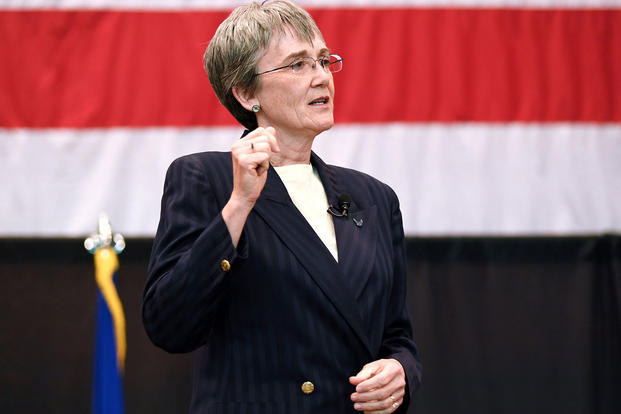NATIONAL HARBOR, Md. -- The U.S. Air Force says it needs 386 squadrons to maintain current operations and to train and prepare for growing future threats from adversaries such as Russia and China, its top civilian official announced Monday.
Air Force Secretary Heather Wilson said the service intends to grow by a total of more than 70 squadrons, as follows:
-
5 additional bomber squadrons
-
7 more fighter squadrons
-
7 additional space squadrons
-
14 more tanker squadrons
-
7 special operations squadrons
-
9 nine combat search-and-rescue squadrons
-
22 squadrons that conduct command and control, intelligence, surveillance and reconnaissance
-
2 remotely piloted aircraft squadrons
-
1 more airlift squadron
"We aren't naive about how long it will take us to build the support and budget required for the force we need. It is a choice," Wilson told audiences here during the annual Air Force Association Air, Space and Cyber Conference outside Washington, D.C.
"To face the world as it is, with a rapidly innovating adversary, the Air Force we need should have about 25 percent more operational squadrons in the 2025 to 2030 timeframe than the Air Force we have," she said.
Related content:
Todd Harrison, director of the Aerospace Security Project at the Center for Strategic and International Studies, said achieving the 25 percent increase will be a large feat, and will depend heavily on what types of aircraft are needed to sustain the Air Force's new goals.
"Right now the Air Force spends about $53 [billion] per year on aircraft operations, training, and recruiting," Harrison tweeted during Wilson's speech. "Increasing the number of squadrons by [roughly] 24 [percent] would probably add another $13 [billion] per year in these operating costs."
The service said earlier this year it was not only redrawing its aviation roadmap to reassess how many fighter aircraft, and potentially other aircraft, it needs to sustain the future fight, but also how many airmen would be part of these operations.
The boost would also enhance the readiness levels the Air Force has slowly been building up in the last few years, following a string of budget cuts and continuing resolutions that capped funding at prior-year levels.
"The Air Force is more ready for major combat operations today than we were two years ago," Wilson said. "We're moving the whole force to higher levels of readiness with actions that will play out over several years, but there are also steps that are making a difference right now."
'Faster, Smarter' Among Growing Threats
Although airmen are consistently upgrading and updating techniques to execute its cyber and nuclear missions, she said the service does not plan to add additional squadrons in these fields.
"In a post World War II-era, we stayed strong, we stayed engaged. And America drove forward in its technical edge in air and space power, never ceding a scrap of technical know-how to our adversaries," Wilson said. "American values backed by American and allied power made the world a more peaceful and prosperous place. ... But our dominance as a global power is not a birthright."
The service currently has 312 operation squadrons, but remains shy of the 386 it needs, Wilson said.
"Three hundred and twelve operational squadrons is not enough. It takes all of us to get that combat power ready and able to fight. A fist is nothing without the weight of the body behind it," she said.
Wilson cited growing threats from Russia and China, which the Pentagon in its National Defense Strategy has pinpointed as near-peer threats the U.S. military may someday go up against in a high-end fight. Their innovative ways in electronic warfare, hypersonics and testing have given the Defense Department reason to prototype and experiment faster, she said.
Russia's recent exercise -- its largest in four decades -- brought 300,000 troops and 1,000 aircraft together. China, meanwhile, recently declared its first aircraft carrier combat-ready, she said.
As a result, "We are buying things faster and smarter," Wilson said. "Over the past six months, Air Force acquisitions has stripped 56 years out of planned schedules in our acquisition portfolio."
She added, "While the Air Force is driving forward, restoring the readiness and lethality of the force, buying things faster and smarter and strengthening our space forces -- in the end, the most important thing we have is people. And the ideas our airmen have to make things better."
-- Oriana Pawlyk can be reached at oriana.pawlyk@military.com. Follow her on Twitter at @Oriana0214.











